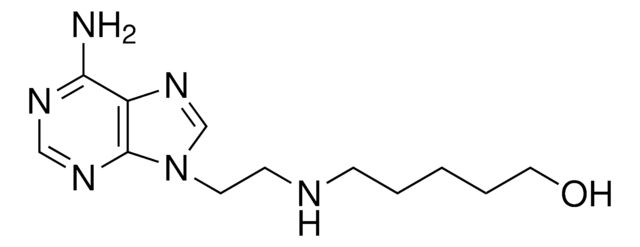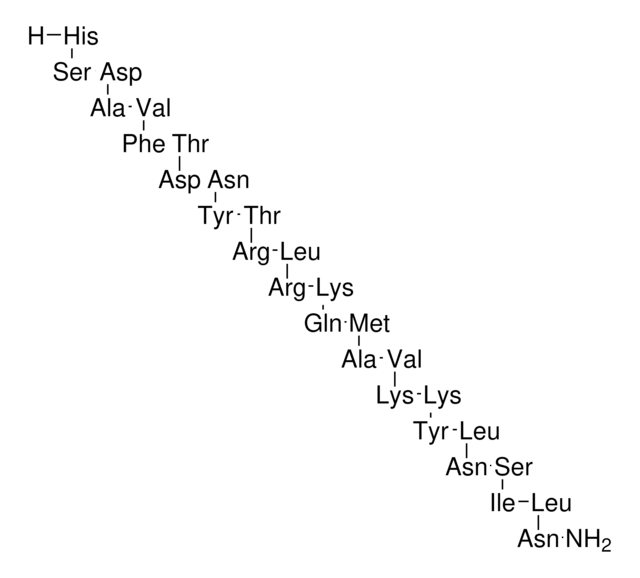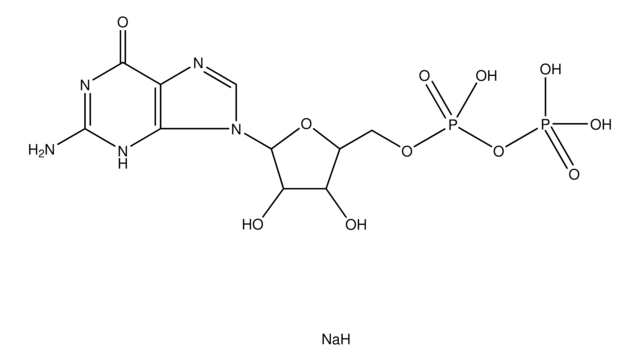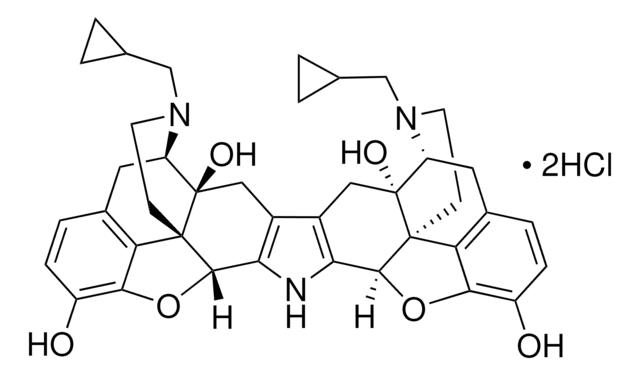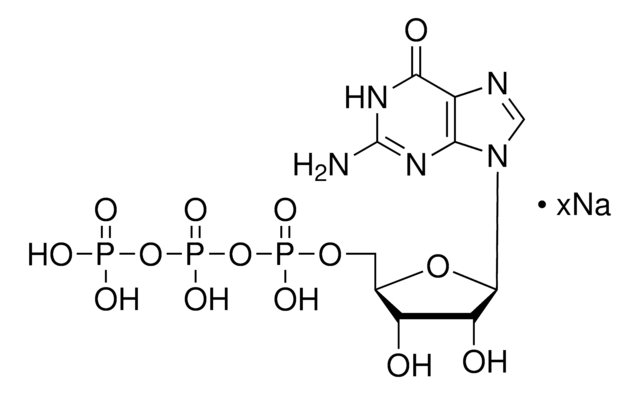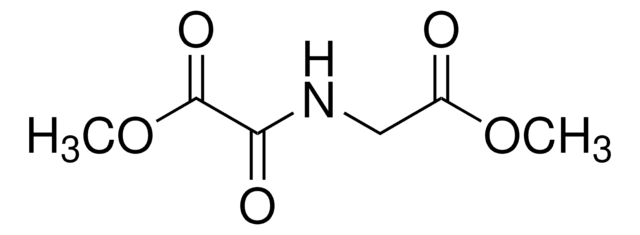A1439
Pituitary adenylate cyclase activating polypeptide-38
Sinônimo(s):
PACAP-38
Faça loginpara ver os preços organizacionais e de contrato
About This Item
Fórmula empírica (Notação de Hill):
C203H331N63O53S
Número CAS:
Peso molecular:
4534.26
Número MDL:
Código UNSPSC:
41106305
NACRES:
NA.32
Produtos recomendados
Formulário
powder
Nível de qualidade
composição
Peptide content, ~70%
nº de adesão UniProt
temperatura de armazenamento
−20°C
Informações sobre genes
human ... ADCYAP1(116)
Amino Acid Sequence
His-Ser-Asp-Gly-Ile-Phe-Thr-Asp-Ser-Tyr-Ser-Arg-Tyr-Arg-Lys-Gln-Met-Ala-Val-Lys-Lys-Tyr-Leu-Ala-Ala-Val-Leu-Gly-Lys-Arg-Tyr-Lys-Gln-Arg-Val-Lys-Asn-Lys-NH2
Descrição geral
Pituitary adenylate cyclase activating polypeptide-38 (PACAP38) is mapped to human chromosome 18. 27-residue-amidated fragment (PACAP27) comprises another isoform. The PACAP38 is major isoform associated with mammals.
Aplicação
Pituitary adenylate cyclase activating polypeptide-38 has been used to test its effect in stimulating the formation of cyclic AMP hypothalamus and cerebral cortex slices of chicken and to treat glioblastoma cells (U87MG) in cell migration assay to test its anti-invasive effects.
Ações bioquímicas/fisiológicas
PACAP-38 is a neuropeptide that has substantial sequence homology to vasoactive intestinal peptide (VIP). It is reported to serve as a neuronal survival factor.
Pituitary adenylate cyclase activating polypeptide-38 (PACAP38) is a cardioprotectant and may help in treating radiation-induced heart disease (RIHD). It plays a protective role during oxidative stress in cardiomyocytes. PACAP38 has antioxidant, anti-apoptotic and anti-inflammatory property. It is implicated in the pathophysiology of migraine and cluster headache.
Outras notas
Lyophilized from 0.1% TFA in H2O
Código de classe de armazenamento
11 - Combustible Solids
Classe de risco de água (WGK)
WGK 3
Ponto de fulgor (°F)
Not applicable
Ponto de fulgor (°C)
Not applicable
Equipamento de proteção individual
Eyeshields, Gloves, type N95 (US)
Escolha uma das versões mais recentes:
Já possui este produto?
Encontre a documentação dos produtos que você adquiriu recentemente na biblioteca de documentos.
Os clientes também visualizaram
J Kinhult et al.
The European respiratory journal, 15(2), 243-247 (2000-03-08)
Pituitary adenylate cyclase-activating peptide (PACAP) 38 displays several biological activities relevant to obstructive airway disease. In this study, the occurrence of PACAP 38 in human small bronchi and corresponding pulmonary arteries was analysed immunocytochemically. The dilatory effects of this peptide
T Dickinson et al.
Neuropharmacology, 38(1), 167-180 (1999-04-08)
Peripheral nerve damage often results in the development of chronic pain states, resistant to classical analgesics. Since vasoactive intestinal polypeptide (VIP) and pituitary adenylate cyclase-activating polypeptide (PACAP) are up-regulated in dorsal root ganglion cells following peripheral nerve injury, we investigated
K Tornøe et al.
American journal of physiology. Endocrinology and metabolism, 279(6), E1413-E1425 (2000-11-30)
The concentration of pituitary adenylyl cyclase-activating polypeptide [PACAP-(1-38)] in porcine adrenal glands amounted to 14 +/- 3 pmol/g tissue. PACAP immunoreactive (PACAP-IR) fibers innervated adrenal chromaffin cells (often co-localized with choline acetyltransferase). Subcapsular fibers traversed the cortex-innervating endocrine cells and
Bernadett Tuka et al.
The journal of headache and pain, 17(1), 69-69 (2016-08-01)
Activation of the trigeminal-autonomic reflex, involving the trigeminal ganglion, the superior salivatory nucleus and the sphenopalatine ganglion (SPG) is crucial in the pathophysiology of cluster headache (CH). Since pituitary adenylate cyclase-activating polypeptide-38 (PACAP-38) is present both in the SPG and
A J Martínez-Fuentes et al.
Endocrinology, 139(12), 5116-5124 (1998-12-01)
We have recently shown that the two bioactive forms of pituitary adenylate cyclase-activating polypeptide, PACAP38 and PACAP27, stimulate GH release and GH messenger RNA (mRNA) accumulation in cultured porcine pituitary cells. However, dose- and time-related differences in the response to
Nossa equipe de cientistas tem experiência em todas as áreas de pesquisa, incluindo Life Sciences, ciência de materiais, síntese química, cromatografia, química analítica e muitas outras.
Entre em contato com a assistência técnica